Seattle, Wash. resident Mimi Kvinge, 28, believes that every day is an art class. Her expansive portfolio across a multitude of mediums showcases her natural talent and dedication to her craft. Kvinge epitomizes the “work hard, play hard’ lifestyle, with pursuits in skiing, mountain biking and fishing. We caught up with Kvinge to discuss femininity in the outdoor industry and the source of her artistic interpretation. Here’s what she had to say.
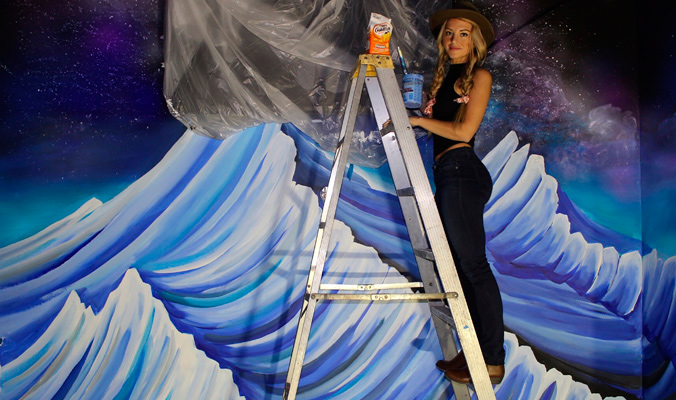
Kvinge at work on her Mountain mural. [Photo] Wil Claussen
Mimi Kvinge: I was brought up in an outdoorsy family that valued imaginative play and being creative. My brother and I were always outside running around, catching frogs and snakes and being creative; we were never screen kids. My mom read to us everyday while my brother and I listened and sketched what we heard. This daily tradition lasted into my late teenage years. It gave me an incredible foundation for being creative and imaginative.
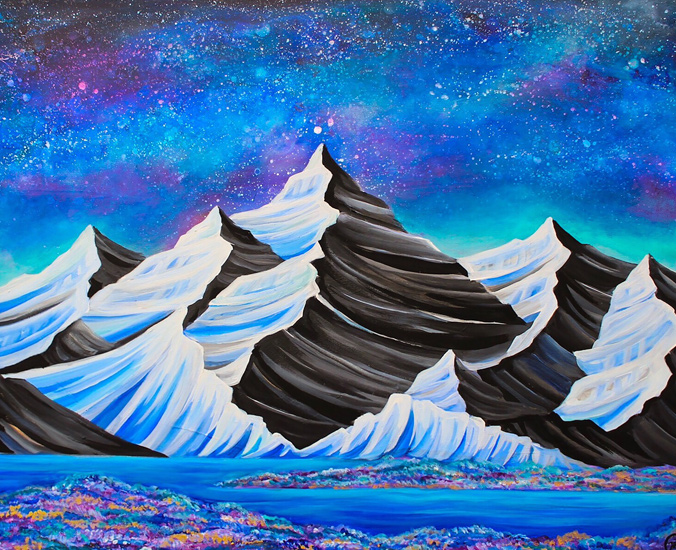
Title: Milk and Honey
My father is a Norwegian immigrant, so in terms of education, I always thought I should choose a practical career. I never thought being an artist was a real job, so I never pursued it formally in my education. All of my art skills are self-taught.
When I was 24, I was working in social work, which I am passionate about, but I just wasn’t happy. I thought to myself, “There has to be more to life than this nine-to-five job.” I started sharing my drawings on social media for fun, and was surprised when people reacted strongly. Slowly, I started taking commission and selling my work. Eventually, I was doing well enough to quit my job and start formally pursuing art. I think forcing myself off the cliff so to speak—and relying on art as a full-time income—really gave me the motivation to be successful.
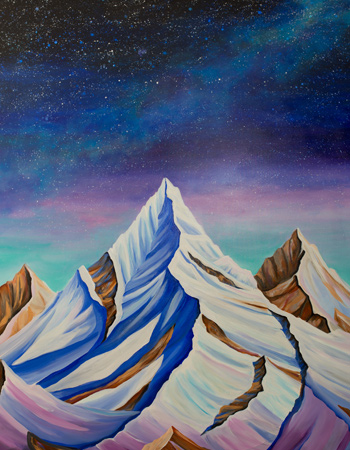
Title: Celestial Love Songs
BCM: What does your creative process look like?
MK: I think something that separates me from many other landscape/outdoor artists is that 75 percent of what I paint comes from my imagination, rather than from a photo or reality. I love to paint outside, but instead of copying exactly what I see, I take shapes and colors from the world around me and use them to form new exaggerated landscapes. For example, I think “POWDER” is my biggest selling print because it touches on something that many skiers can identify with. When I am skiing, it’s one of the few times in my adult life I truly feel like a kid again. Using that color spray really highlights the feeling of magic and joy.

Title: Powder
BCM: Tell me about the type of backcountry skiing you like to do.
MK: My resort skiing came to a point where I didn’t enjoy it that much; it felt like bumper cars. I like to ski because it’s a beautiful, meditative experience that’s more about me and my body. Three or four years ago, I started getting into backcountry skiing, and it’s been perfect for what I like—I enjoy the speed of it. I can take it as fast or slow as I like, especially because I like to stop and draw on the way. It’s still something I am learning and this will be the first year I won’t be getting a pass, because my focus is going to be all backcountry.
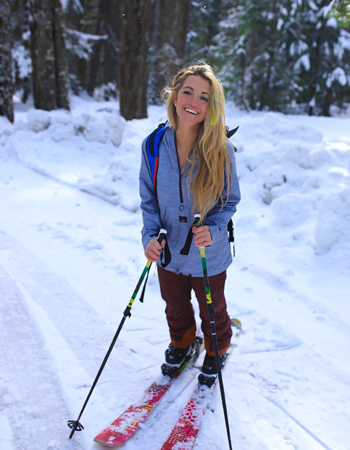
Kvinge finds creativity on the skintrack. [Photo] Wil Claussen
MK: I am introverted and, in a lot of ways, I feel very grateful to social media for connecting me with so many great people and ideas, but I think that as a medium, social media can be really toxic. I have this constant war going on in my mind where I want to be really mindful and present—not taking photos all the time [for social media]. But if I look at the analytics of my business, promoting myself on social media directly relates to sales. I think doing these large collaborations [outside of social media] allows me to step back from promoting and being the “face” of my brand, and allows me to focus on working, on painting. Eventually I’d like to operate my business from behind-the-scenes. When your business is both your art and also your lifestyle, the line between private life and brand can be blurry. This is something that often makes me uncomfortable.
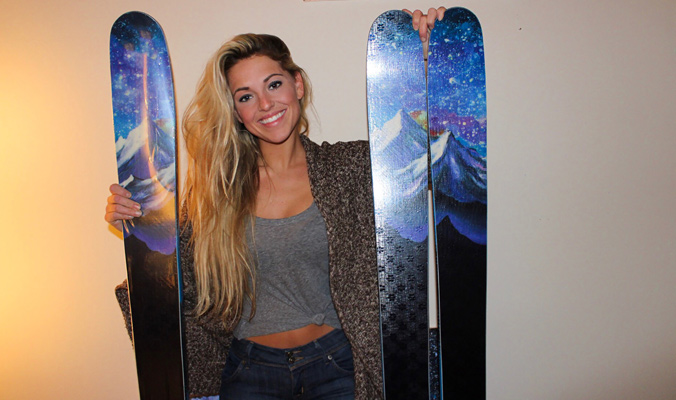
Kvinge with the LibTech Wonderstick sporting her topsheet artwork. [Photo] Wil Claussen
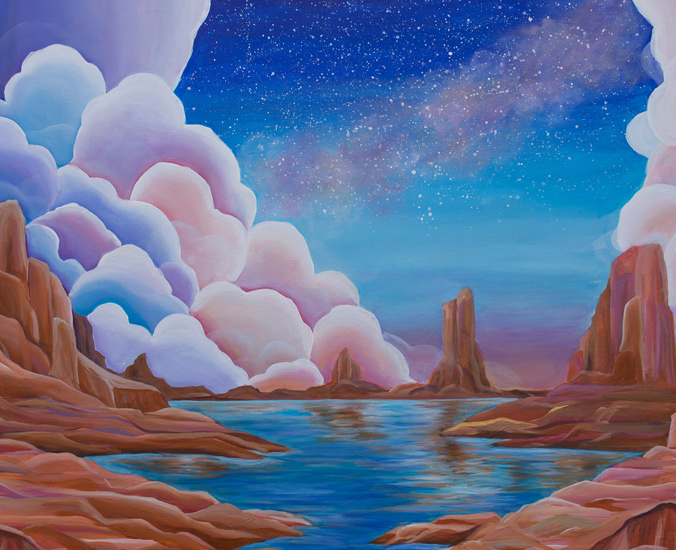
Title: Southwest
BCM: What role does femininity play in your work?
MK: I see a lot of parallels between nature and the feminine: power, beauty, unpredictability, life sustaining, and that it’s often undervalued. I always think of my paintings as being female; the colors I choose, the landscapes I paint are feminine and ferocious. Many of my personal sketches I don’t share on social media explore this concept more heavily and more literally. This work however for now, is just for me. I also try to empower other women through my work and through my brand. Because the outdoor industry is so male-dominated, there is this impression that you have to hide your classically “feminine” qualities and put on a masculine cloak in order to be taken seriously. As an example, I am an athlete and an outdoors woman, but I also love fashion as a form of 3D art that I can be creative with. Does this make me less of a skier or fisherwoman or artist? No, but to some people, yes. Being comfortable in your skin as a female and embracing your femininity—in whatever individual way that is—are not mutually exclusive with being a talented, athletic badass. We live in a time where women are allowed to check more than one box, to be many different things all at once. At the end of the day, I see my entire life as my largest canvas, and I will not be changing how I choose to paint it in order to fit into someone else’s stereotype.
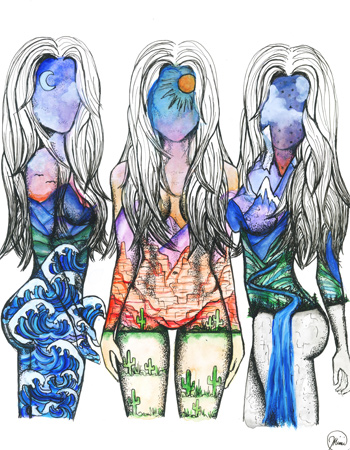
Title: Wildii
—
To view more of Kvinge’s work, visit mimikvinge.com.











Related posts:
Skintrack Sketches: Freeskier Chris Benchetler tops things off with graphic design
Skintrack Sketches: Lori LaBissoniere finds her inspiration in the Pacific Northwest's remote landsc…
Skintrack Sketches: Painter Rachel Pohl talks balancing reality and the conceptual in the mountains
Skintrack Sketches: Gianna Andrews takes the silver linings in life and paints them